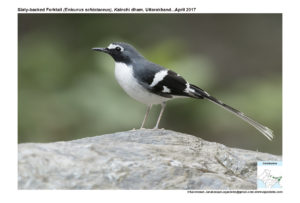Slaty-backed Forktail

Slaty-backed Forktail Enicurus schistaceus
Etymology:
- Enicurus : Greek word henikos – singular; ouros -tailed
- Schistaceus : Latin word for Slate Grey
Vernacular names: Naga: Inruidiba
Distribution in India: Resident of Himalayas and North East India
Description: Size of 22-25 cm; wt. of 26–38 g. The slaty-backed Forktail is a slim, medium-sized Forktail. It is coloured slate-grey, black, and white. The bill is black, while the feet of the bird are a pale pinkish or greyish colour. The iris is dark brown. It has a black throat and a narrow white stripe across its face till just behind the eyes. Its ear coverts, chin, and face are also black. The forehead, crown, sides of the neck, and the scapulars are slate grey. It has black wing-coverts, a white patch at the base of the primaries, wide white bars on otherwise black wings, and also a large white patch on its rump and lower back. The bases of the flight feathers are white, which is occasionally visible as a little additional bar on the wing. The tail of the bird is long and evenly graduated, with a deep fork. The tail is largely black except for a white tip. It also has three white bands along its length, formed by the white tips of shorter tail feathers.
Habitat:It is found in larger rivers in valleys, often in open country. It breeds at 300–1600 m in Himalayas, wintering down into adjacent plains.
Food Habits: It feeds on small invertebrates found in or around the water, including larvae and crustaceans. It forages at the edge of the water, and is described as “moving restlessly”. It forages on and among rocks at the edges of the water as well as in mid-stream; it will occasionally enter the water as well. Though it generally forages by hopping in an agile manner among rocks, it also makes brief forays above the water to snatch food items from the surface.
Breeding Habits: They breed in Feb-Jun. The nest is a cup or semi-dome built of compacted bryophytes, grasses, leaves and leaf skeletons, lined with plant fiber and leaf skeletons, attached to rock or boulder with mud, in one instance placed in stump leaning over stream, in another on fern-covered embankment above mill-race. They lay a clutch of 3-4 eggs. Both parents incubate the eggs for 3 weeks .